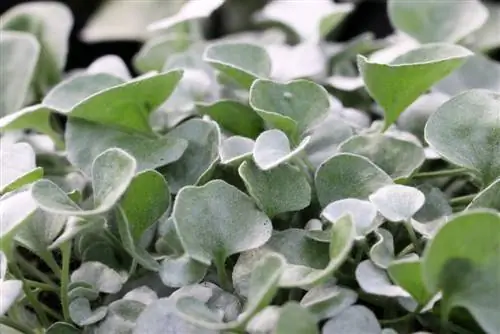- Author admin [email protected].
- Public 2023-12-17 03:39.
- Last modified 2025-06-01 06:48.
As soon as silver rain plants let their shoots hang down, they live up to their name. It actually looks like pieces of silver from the Dichondra argentea are falling to the ground. The shoots of the discreet flowering plant with its rounded leaves, which can fall up to two meters deep, make the plant ideal for cultivation in a hanging basket or as a balcony plant.
Dichondra argentea - the characteristics
In the morning glory plant family there are 9 species of trailing plants related to the sweet potato. Silvery, shimmering, grained leaves are the trademark of this effective hanging plant, which makes it particularly decorative. In summer, real mats spread out from which shoots up to more than 2 meters long hang down like silver strings of coins and attract the eye.
Delicate beauty in bloom
Silberregen can serve wonderfully as a background plant for combinations with other flowering plants, which provide a nice contrast to the silvery appearance. The silvery beauty itself blooms rather inconspicuously with light green, bell-shaped flowers that always fit well into the overall picture. The foliage ornamental plant looks particularly exciting in combination with red perennials or other summer flowers in strong colors.
Silver shine in the sunshine
- a magnificent ornament in the garden -
Silver rain grows particularly well in loose soil or potting soil if it is given a sunny spot. Within a short time it forms dense, effective bundles that should only be watered moderately. Fertilization is rarely necessary. By the way, silver rain can also be used excellently as a ground cover. Dichondra argentea is a fairly easy-care plant that thrives without any problems. Even extreme heat and drought can hardly harm the ornamental plant. The evergreen plant is also hardy, which means it is always a beautiful eye-catcher in the garden. Only strong frost cannot tolerate the unique beauty.
Cultivation of the robust plant
The silver rain requires a distance of around 20 cm between the individual plants in order to be able to spread to your heart's content. The sun-hungry leafy plant can also be happy in partial shade if there is no free spot in the sun. Seedlings can ideally be sown in mid-January, when the temperature is around 16 to 20 °C. After about 10 days the first germs emerge and after 20 weeks the Dichondra argentea are fully grown. Perennial seedlings can be grown in a cold frame under glass between January and March or grown in pots under glass on a sunny windowsill. However, the relatively easy-care climbing plant does not like waterlogging or dryness during germination. The seeds should also be kept very warm. The seedlings can be transplanted from mid-May.
Tip:
The climbing plant always finds a way to the light. Place the pot in a partially shaded area and let the silver rain grow towards the sun. The soil does not dry out as quickly because the pot is not exposed to direct heating from the sun.
Caring for the silvery climbing plant
An optimal supply of nutrients is essential for the silver rain to thrive perfectly. The plant substrate provided in spring should therefore already contain numerous nutrients. To ensure that the individual plants do not suffer from a deficiency throughout the year, occasional fertilization is recommended during the summer. However, adding liquid fertilizer every 2 to 3 weeks is completely sufficient. Basically, there should be a little restraint when watering. It should only be watered when the soil has dried to a depth of at least 2 cm. As I said, Dichondra argentea reacts allergically to waterlogging.
Overwintering the silver rain plants
This beautiful climbing vine originally comes from tropical to subtropical zones. The ornamental plant is often only kept as an annual. However, the silver rain can definitely be overwintered. The plant feels at home in a bright spot at around 10 to 15 °C in winter. It should not be below 15 °C, otherwise growth would stop completely. The plant then tends to extend this resting phase, which would not be beneficial for magnificent growth after winter.

During the winter phase, watering should be reduced rapidly. Extensive pruning followed by repotting in the spring brings the silver rain out of its hibernation. Pruning can be done both at the beginning of winter and in spring. The silver rain then sprouts completely again. Then you have to water regularly again. Once the danger of frost has been averted from May, the plant can go outdoors again. However, you should choose an overcast day so that the sun does not burn the tender leaves.
Easy propagation from subtle green plants
Silver rain can certainly be propagated with seeds and pricking out. However, it is not for everyone to wait patiently until the small plants have reached a certain size. Of course, specialist retailers also have young plants available that you can plant straight away. Tip: Dichondra argentea is even easier to propagate by simply pinching off shoots that are approximately 5 cm long and sticking them directly into the soil. A bright place protected from direct midday sun is ideal for the cuttings. The cuttings produce roots relatively quickly. As soon as the cuttings have rooted, the plants can be transplanted.
Frequently asked questions about the treatment of silvery beauties
Can silver rain be combined with other plants?
Basically, the ornamental plant Dichondra argentea is a very sociable plant. However, very demanding plants that have high nutrient requirements should be kept in mind. Because the silver rain is quite dominant when it comes to nutrients. So the other plants could also come away empty-handed.
Flower box with silver rain - how many plants can fit in it?
Since the individual hanging plant plants spread out and require a certain amount of space, it is recommended not to plant them too densely. For a 60 cm flower box we recommend five plants with a planting distance of approximately 20 cm per plant.
Can silver rain overwinter in the flower box outside?
Since the leafy ornamental plant is winter-proof but not frost-proof, the flower boxes should be taken indoors. It should be ensured that the room in which the flower boxes are stored has a room temperature of around 10 to 15 °C. With the wintering tips mentioned above, you will have silvery splendor on your balcony again next spring.
What you should know about silver rain in brief
Plants
- When planting, a distance of 15-20 cm should be maintained from the next plant so that the silver shower can spread to your heart's content.
- As a sun-hungry plant, it needs at least a partially shaded spot if full sun is not possible.
- The specialist retailer offers not only plants, but also seeds.
- The sowing should ideally take place from mid-January at a temperature of around 20° C.
- Germination occurs after about 10 days and it takes about 20 weeks until the plants are fully grown.
Care
- The silver rain needs an optimal supply of nutrients to thrive.
- The plant substrate that is provided to the silver rain in spring should already contain numerous nutrients.
- To ensure that there is no deficiency during the summer, we recommend adding liquid fertilizer every 2-3 weeks.
- Watering should be done rather cautiously and always when the soil has dried to a depth of at least 2 cm.
- Waterlogging should definitely be avoided.
Wintering
- Silver rain is usually only kept as an annual, although it can also overwinter.
- The location should then be in a bright place in the house at around 10° to 15° C.
- Below 15° C, the silver rain stops growing completely.
- Once it is programmed to the rest phase, it extends this state for a long time.
- Watering must then be reduced rapidly.
Tip:
Whether in the same company or in combination with other flowering plants, silver rain always looks attractive. It can also form the background like a kind of silver curtain on which hanging flowering plants in strong colors stand out in contrast.
To awaken the silver rain from its hibernation in spring, extensive pruning followed by repotting and watering again helps. From May, when the danger of frost has passed, the silver rain can go outdoors. But this should be done on a rainy day, otherwise the sun will burn the leaves.
Conclusion
Silver Rain lives up to its name, but it needs some attention to thrive. If you want to overwinter the silver rain, you should keep it in a cool but bright place.






